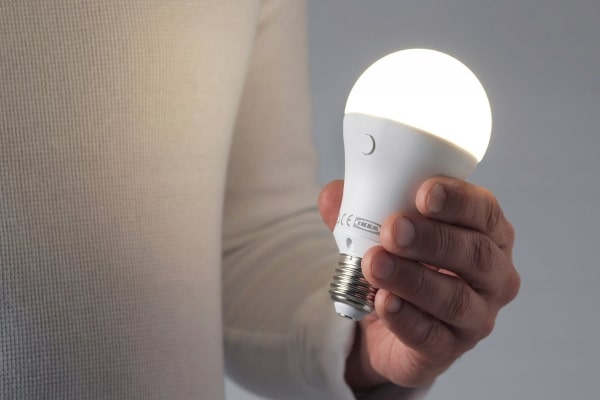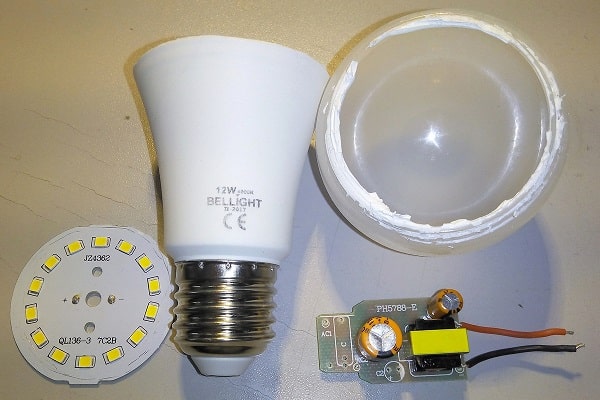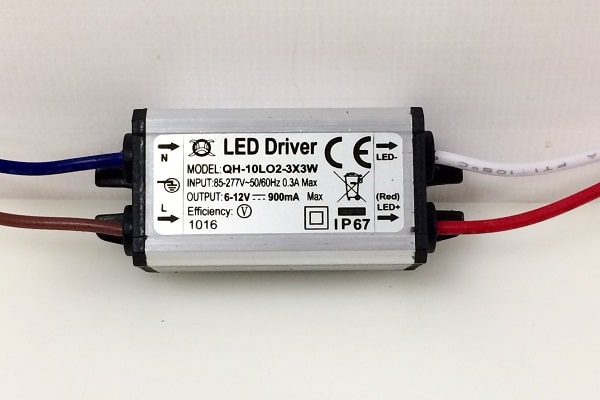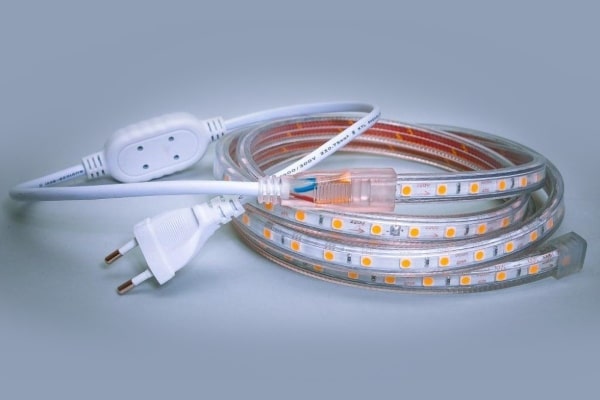Common types of lamps on the Russian market are halogen, fluorescent, standard incandescent lamps and LED light sources. Of all categories, LEDs are leading today. Analogues are inferior to them in a number of criteria, the main of which is the power indicator relative to energy consumption.
What power are LED lamps?
The power of LED lamps varies from 1W to 14W. It is important to understand that the power rating does not determine the brightness of the lamp. The 7-watt LED lamp shines with the same intensity as a classic 60-watt incandescent lamp.
There is also the concept of “power factor of LED lamps”. This value is equal to the ratio of the active power of the applied load to the apparent power. The last parameter indicates the product of the RMS value of voltage and current.
How is the power of LED lamps measured?
The first and most important characteristic for buyers is the power of the LED backlight. The efficiency of lighting depends on the indicator. The power of a diode lamp is measured in watts.
The power characteristics declared by the manufacturer on the packaging may sometimes not correspond to reality and expectations. Pay attention to the parameter of the luminous flux of the led lamp – it is he who is responsible for the brightness.
What parameters are affected by the power of the LED?
In addition to power, when choosing an LED lamp , look at a few more technical characteristics. All of them affect the quality of lighting.
Light flow
Light emitted by a diode or other source is called luminous flux and is measured in lumens (lm). For convenience of choice, the manufacturer indicates on the package the equivalent of the lamp in the familiar Watt system. But often, when users come home, they find that the analogue of 60 watts shines dimly.
People are accustomed to determine the brightness of the glow of lamps in watts. Ask anyone which lamp is the brightest. They will answer you: “Of course, 100 watts.” Therefore, a value of 3-6 W can be confusing. To avoid confusion, remember that watts determine the energy consumed, and the degree of brightness depends on other values.
When choosing an LED lamp, pay attention not to power, but to lumens. It directly depends on how much light will be in the room. Information is displayed on the packaging, but usually in small letters.
How to determine the brightness of an LED: the more lumens, the brighter the source light. Values in lamps from different manufacturers may not match. It all depends on the quality of the parts. For cheap Chinese samples, this figure is much lower than for well-known brands.
What are the proven companies in the LED lamp market:
- Xiaomi;
- Philips;
- Megaman;
- Osram;
- IKEA
- Feron, etc.
Brightness with the same lumens may also differ between new and old light sources. If possible, always ask the seller to check the lamp in front of you.
Light output
The optical efficiency of an LED lamp (light output) is the ratio of the luminous flux emitted by the lamp to the amount of power simultaneously consumed from the power source. That is, energy efficiency or the efficiency of converting electricity into light.
LEDs with a power of 1-20 W have a light output of 40-120 lm / W. But since all manufacturers show in the description the maximum performance of their lamps under ideal conditions, the actual life and light output will always be less.
Colorful temperature
When choosing a lamp, take into account the type of glow. It is also called the color of the light flux or color temperature. The indicator is measured in Kelvin (K) and there are three main types:
- warm (2700-3000 K);
- neutral (4000-4100 K);
- cold (5000–6500 K).
The first one is yellow. The latter is considered brighter. And the neutral white matches natural daylight.
To spend time in the room comfortably:
- Do not choose bright fluorescent lamps, which are most often used in offices and industrial facilities.
- It is better to prefer a color temperature in the range from 3000 to 4000 K. Such lamps most closely resemble the normal yellow glow of sunlight.
On the packaging of the lighting device, the type of glow can be written in text. Choose options labeled “warm white” or “soft white”.
The weight
Unlike classic lamps, LED sources have additional elements – drivers and other parts that increase weight. When choosing an LED light fixture, consider how much it weighs, especially if the light bulbs are inserted into chandeliers and other prefabricated structures.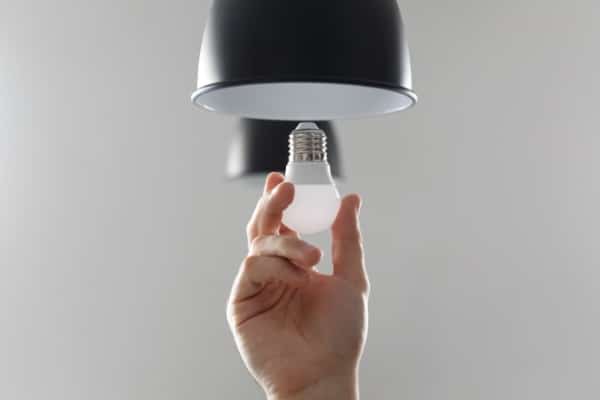
A large mass of LED lamps has the advantages of increased reliability, durability, and longer service life.
Scattering angle
Beam angle is a measure of how light propagates from a light source to surfaces. Calculated in degrees. Lighting devices of different types and structures shine in different ways:
- Classic incandescent lamps give light in all directions and have a maximum of 360°.
- Halogen spots produce a narrow directional beam of light. Their illumination angle is from 8° to 60°.
With the angle of scattering of LEDs, everything is more complicated. Many LED sources that replace traditional incandescent lamps have a hemispherical base of the same diameter as the lamp itself. They do not reflect light, and when the lamp is directed downwards, the ceiling remains dark, which is sometimes inconvenient.
Recently, many light bulbs have appeared with a transparent cap, which is larger than the lamp body, due to which a small amount of light also hits the back (on the ceiling).
Beam angles of different LED sources:
- Filament diode lamps have the same wide angle of illumination as traditional incandescent lamps.
- Most LED fixtures (ceiling lights with GU10 and GU5.3 bases) emit ambient light at an angle of around 100° and create glare due to too much angle.
- Conventional LEDs have a dispersion index of 120°.
- Some diode spots have a narrow beam spreading angle – like halogen lamps. They are easy to identify by the lens that is located in front of the LEDs.
Equivalent power of other types of lighting
The table shows the ratio of power and luminous flux for incandescent, fluorescent and LED types:Fluorescent lamps, W Incandescent lamps, W LED lamps, W Luminous flux, Lm 6-7 twenty 2 200 10-13 25 3 250 15-16 40 4-5 400 18-20 60 eight 650 25-30 100 fourteen 1300 40-50 150 22 2100 60-80 200 25 2500
The most common misconception is that a 10W LED is equivalent to a 100W incandescent bulb. In fact:
- Powerful LED lamps have frosted flasks to protect the eyes (especially for children). Such a bulb reduces the brightness by 20% + 1 watt is spent on heating the driver (10 * 20/100 = 2, and plus 1 = 3 W).
- As a result, we get only 7 watts of useful power. On average, this is 700-800 Lumens, which does not reach the required 1300 Lm, which is emitted by a 100 W incandescent lamp.
It is also worth mentioning energy-saving lamps. Sources with low consumption have the highest efficiency during continuous operation, but with frequent switching on and off, they spend several times more energy on heating and at first turn on only at half power, gradually flaring up.
Correspondence table for energy-saving and LED lamps:Energy saving, W LEDs, W Luminous flux, Lm four 3 250 9 5 400 13 eight 650 twenty fourteen 1300 thirty 22 2100
How to choose lamps by power?
When choosing an LED lamp, be guided by the correspondence table above. Having found the usual power of an incandescent lamp in it, you can easily find out the required indicator for an LED source by simply looking at the next line.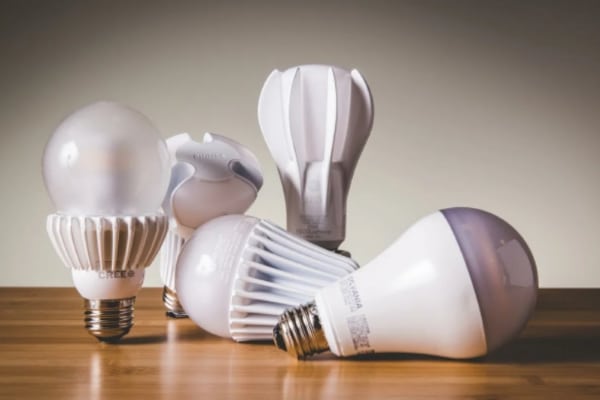
For example, if you are looking to replace a 60W light bulb, buy an 8W or 650Lm LED source.
What additional features do LED lamps have:
- Many lamps have drivers with stabilizers, which is especially important for large voltage fluctuations in the network (while the brightness of the lamps and power does not change).
- Some devices have built-in batteries for autonomous switching on – they can be powered from a battery of minimum power.
- There are specialized dimmable LED fixtures that are compatible with power controls ( dimmers ).
- LEDs can emit different colors due to the use of RGB diodes (red, green, blue) – this does not affect the number of watts.
- There are light sources that can be controlled remotely or via Wi-Fi – you also don’t have to worry about increased power consumption.
It is recommended to calculate the optimal lighting power when repairing and installing fixtures. So you will always know the number of watts that should be in the lamps, and how many illuminators are needed.
If you want to know how much power LEDs should have in a particular room, consider the following parameters:
- room size (RP);
- estimated number of luminaires to be installed (CS);
- luminous flux (SP);
- the level of illumination of the room (UO).
To calculate the luminous flux of a lamp, use the following formula: SP \u003d UO * RP / KS. If you need to know the level of brightness per square meter, use the expression: BL = KS * SP / RP.
You can also use a special online calculator for calculations, for example https://www.calc.ru/osveshchennost-pomeshcheniya-kalkulyator.html. Enter the parameters that are written above. The system will then automatically calculate the optimal lighting level for the room.
The effective illumination angle of the LED is about 120 degrees. Calculate the position so that enough light falls on each square meter.
If the light bulbs are not screwed into the chandelier, but used independently, in the form of ceiling lights, their light intensity should be 1/2 times higher.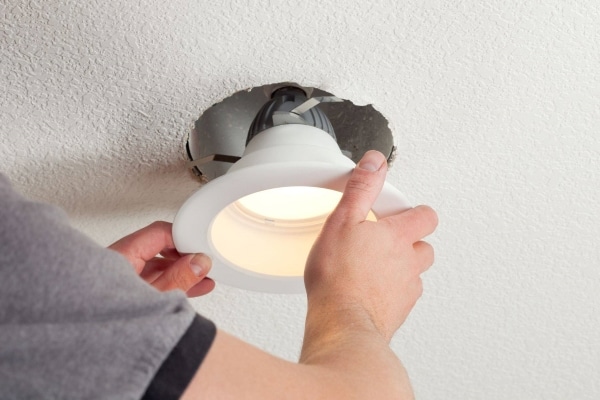
To organize the lighting of standard (square, rectangular) rooms, you can pay attention to the classic power calculation table:Room type Specific power of LED lamps per 10 sq. m, W Required illumination, Lm (minimum) Living room, bathroom thirty 2000-2500 Sauna, swimming pool 13-20 1000-1500 Bedroom, hallway, corridor twenty 1500 Library 39 3000 Kitchen 40 3000 Wardrobe 13-20 1000-1500 Children’s fifty 4000 Office for PC 39 3000 The meeting room 26-39 2000-3000 Utility rooms ten 750-1000 Drawing room 65 5000
Much depends on the correct choice of LED lamps. High-quality light bulbs can significantly reduce utility bills for lighting. Today, LEDs save up to 85% of costs in this category. In addition, LED light is as close to natural as possible, which has a beneficial effect on human health and well-being.


